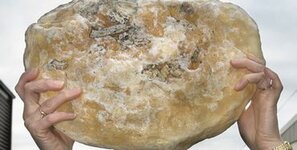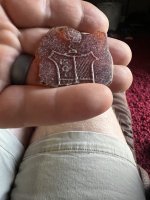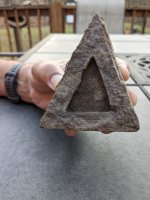kenb
Bronze Member
Search for Bee's wax wreck comes up empty
Sensors' clue leads to railroad debris, not galleon
Nehalem Bay - Searchers eliminate one area that could have held wreckage from the long-lost "Beeswax Ship" Wednesday, September 26, 2007RICHARD L. HILL The Oregonian Staff
MANZANITA -- The whereabouts of a 17th century Spanish galleon that wrecked on the northern Oregon coast about 300 years ago remains elusive.
A team of about 20 researchers and divers spent last weekend at Nehalem Bay State Park looking for remains of the trading ship. The three-day search for the "Beeswax Ship" -- so called for its cargo of Philippines beeswax -- found no signs of the vessel, but project leaders say they plan to return next spring to continue their work.
The researchers focused on sites at the bottom of Nehalem Bay. In May, sensors had detected irregularities in magnetic fields there during an initial phase of the project. The anomalies could pinpoint cannon or other objects from the ship.
But divers found only wooden railroad ties and rails that apparently had been dumped into the bay long ago. Rough ocean conditions prevented them from exploring potential sites offshore.
"We accomplished a lot in three days," said Scott Williams, a Washington state archaeologist who is leading the project in his spare time. "We can now eliminate some sites and move on to other places that show promise. We knew this was going to be challenging work."
The wreck has been well-known for more than 150 years. Native Americans and 19th-century settlers made use of the shattered ship's teak timbers and abundant blocks of beeswax.
The Spanish galleon probably was on its way to Acapulco, Mexico, after picking up its cargo of Chinese porcelain and beeswax in Manila, Philippines. A storm may have blown the ship off course, and it wrecked near the mouth of Nehalem Bay.
Any survivors could have been the first Europeans to make contact with Native Americans in the Northwest.
The ship's cargo of several tons of beeswax, prized for candles, was strewn throughout the area. Blocks of the beeswax, stamped with numbers and other designs, are on display with other artifacts at the Tillamook County Pioneer Museum in Tillamook
Evidence, including records of missing galleons, has narrowed the vessel's possible identity to two ships: the Santo Christo de Burgos, which vanished in 1693, and the San Francisco Xavier, which disappeared in 1705.
The search for the ship is supported by the Naga Research Group, a nonprofit archaeological organization based in Hawaii. (Information: www.nagagroup.org/BeesWax/about/about.htm)
Researchers hope to renew the hunt in May.
"We're just beginning the search," said Jack Peters, a project staff member from Springfield. "The ship isn't going to give herself up easily."
Richard L. Hill: 503-221-8238; [email protected]
kenb
Sensors' clue leads to railroad debris, not galleon
Nehalem Bay - Searchers eliminate one area that could have held wreckage from the long-lost "Beeswax Ship" Wednesday, September 26, 2007RICHARD L. HILL The Oregonian Staff
MANZANITA -- The whereabouts of a 17th century Spanish galleon that wrecked on the northern Oregon coast about 300 years ago remains elusive.
A team of about 20 researchers and divers spent last weekend at Nehalem Bay State Park looking for remains of the trading ship. The three-day search for the "Beeswax Ship" -- so called for its cargo of Philippines beeswax -- found no signs of the vessel, but project leaders say they plan to return next spring to continue their work.
The researchers focused on sites at the bottom of Nehalem Bay. In May, sensors had detected irregularities in magnetic fields there during an initial phase of the project. The anomalies could pinpoint cannon or other objects from the ship.
But divers found only wooden railroad ties and rails that apparently had been dumped into the bay long ago. Rough ocean conditions prevented them from exploring potential sites offshore.
"We accomplished a lot in three days," said Scott Williams, a Washington state archaeologist who is leading the project in his spare time. "We can now eliminate some sites and move on to other places that show promise. We knew this was going to be challenging work."
The wreck has been well-known for more than 150 years. Native Americans and 19th-century settlers made use of the shattered ship's teak timbers and abundant blocks of beeswax.
The Spanish galleon probably was on its way to Acapulco, Mexico, after picking up its cargo of Chinese porcelain and beeswax in Manila, Philippines. A storm may have blown the ship off course, and it wrecked near the mouth of Nehalem Bay.
Any survivors could have been the first Europeans to make contact with Native Americans in the Northwest.
The ship's cargo of several tons of beeswax, prized for candles, was strewn throughout the area. Blocks of the beeswax, stamped with numbers and other designs, are on display with other artifacts at the Tillamook County Pioneer Museum in Tillamook
Evidence, including records of missing galleons, has narrowed the vessel's possible identity to two ships: the Santo Christo de Burgos, which vanished in 1693, and the San Francisco Xavier, which disappeared in 1705.
The search for the ship is supported by the Naga Research Group, a nonprofit archaeological organization based in Hawaii. (Information: www.nagagroup.org/BeesWax/about/about.htm)
Researchers hope to renew the hunt in May.
"We're just beginning the search," said Jack Peters, a project staff member from Springfield. "The ship isn't going to give herself up easily."
Richard L. Hill: 503-221-8238; [email protected]
kenb





